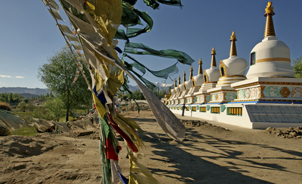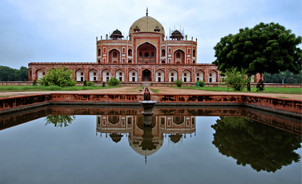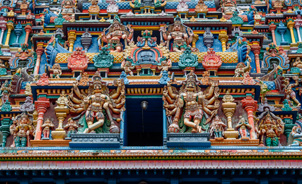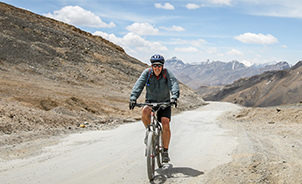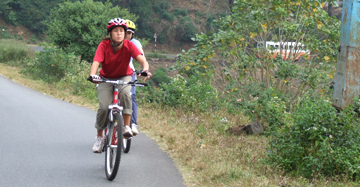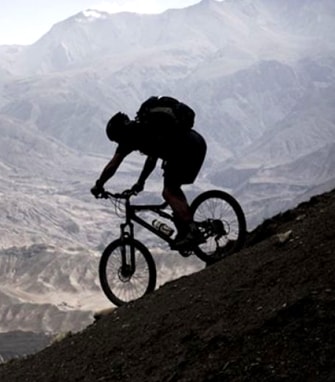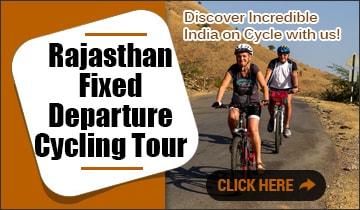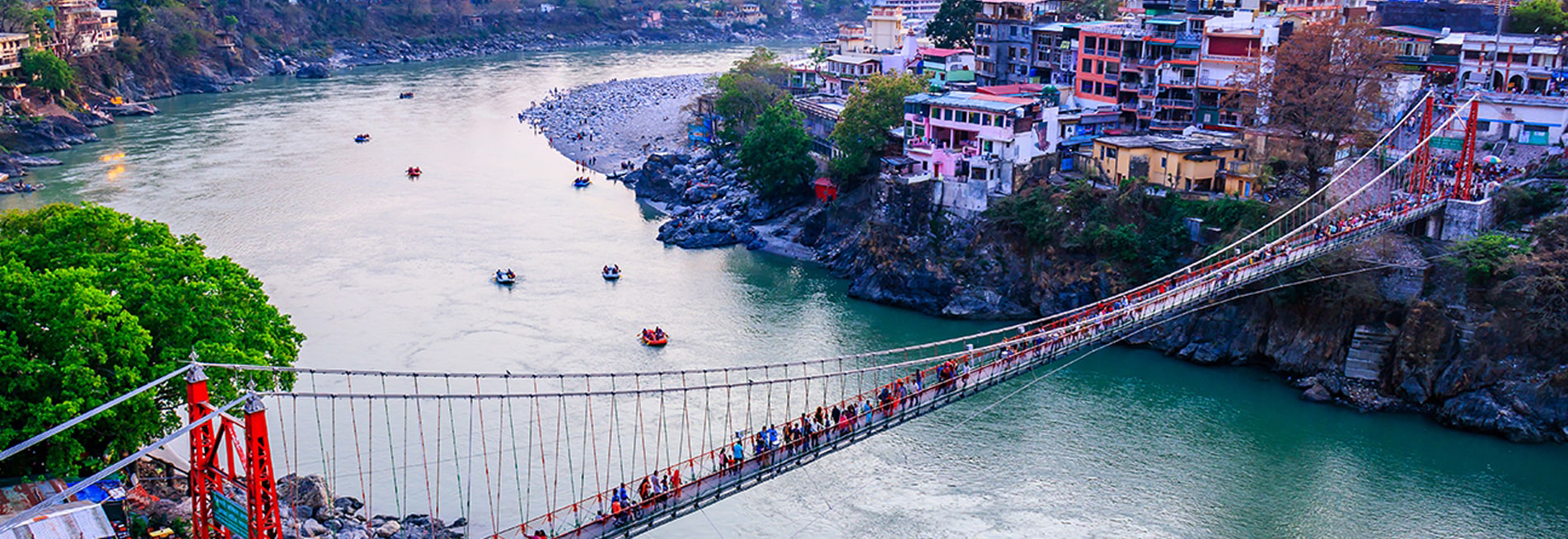
Cycling in Garhwal Himalayas
Our cycling tour of Garhwal Himalayas is set in the most stunning mountainous landscape of Uttarakhand in north India.
From the holy town of Rishikesh to the source of the river Ganges at Gangotri, we cover the popular hill stations, holy towns, and remote villages to give you a Himalayan biking adventure that tests your mettle and reveals some rare aspects of the Indian culture and spirituality at the same time.
The 16-day Garhwal cycling trip kicks off with a sightseeing tour of Delhi, India’s capital. The action soon shifts to Rishikesh – the town where The Beatles came looking for salvation in the 1960s, and discovered transcendental meditation at a guru’s ashram. You get to make your own little discoveries at the temples, ghats, and ashrams during our daylong sojourn in Rishikesh before we hit the long road towards the source of the Ganges.
The biking route to Gangotri winds up into the Himalayan mountains along the circuitous course of the river Bhagirathi, which is a source stream for the Ganges. We start off at the comfortable altitude of 372 meters at Rishikesh and gain elevation with each day’s biking into the Himalayas. Make no mistake, cycling in Garhwal mountains is no ride in the park and there are some strenuous stretches demanding your utmost pedal power and endurance. But the good part is you are welcome to hop into our backup cab whenever you need a breather.
It takes us a week of cycling to get from Rishikesh to Gangotri at 3200 meters. Along the way we pass towns and little-known villages in a landscape that keeps changing from verdant hills to arid mountains to wuthering passes. There’s no telling the number of temples you come across on the route. Uttarakhand is often called ‘Dev Bhumi’ or the land of Gods, and here you find temples – famous and nondescript – devoted to hundreds of gods in the Hindu pantheon.
The most important stopover is Uttarkashi, which is hailed as the Varanasi of the mountains. Thousands of devotees pay their obeisance here at the Vishwanath Temple before continuing their journey to Gangotri. Two more days of cycling takes us to Gangotri, which is one of the four holy pilgrimage sites in the Chota Char Dham circuit. The river Ganges originates here at a place called Gaumukh, which literally means a cow’s mouth.
The Garhwal biking trails end at Gangotri. Here we turnabout and go back the way we came, but choose to overnight at the towns we passed by on our journey previously. On the twelfth day of our Garhwal cycling tour, we change the route and leave the road alongside the river Bhagirathi to take the highway going westward to Yamunotri, the source of the river Yamuna. We explore the enchanting landscape of north-western Uttarakhand for three more days before turning south towards the popular hill station of Mussoorie, where we conclude our biking tour of Garhwal Himalayas.
This tour is strongly recommended to the bikers looking for a mix of Himalayan biking adventure and Indian spirituality. Many a night we camp out and dine in tents. Many a town we stop by to briefly explore. And all this takes place against the backdrop of a dreamy Himalayan landscape that knocks your breath out more than the rigours of biking do.
Do check out our detailed itinerary for an in-depth look at all the marvels that await you on our Garhwal biking tour. .
Delhi - Rishikesh - New tehri - Dharasu - Uttarkashi - Bhatawari - Harsil - Gangotri - Gangnani - Uttarkashi - Barhmakhal - Barkot - Nainbag - Mussoorie - Delhi
15 Nights / 16 Days
ARRIVAL IN DELHI
India’s national capital, Delhi, is the starting point of our Garhwal cycling holiday. Our representative meets you at the Delhi Airport and transfers you to a pre-booked hotel.
Delhi is usually the first port of call for any travel holiday in north India. It’s a bustling metropolis with its own historical and cultural heritage, which needs a full day of exploring. So, we let you relax and get over jet lag on the first evening of your overnight stay at the hotel in Delhi.
DELHI SIGHTSEEING TOUR

After breakfast, we take you out on a guided sightseeing tour of Delhi. There’s so much to explore and discover that you better keep your cameras at hand. Old Delhi, with its monuments, mosques and markets, is an intriguing vignette of India’s Mughal heritage. The great Jama Masjid, Chandni Chowk market, and Red Fort draw thousands of locals and tourists every day.
New Delhi presents a rather contrasting picture. The secular monuments like Jantar Mantar (a gigantic sundial), India Gate and Rashtrapati Bhavan (President’s House) have Rajput and British architectural influences. The Laxminarayan Temple, Akshardham Temple, ISKON Temple, and Lotus Temple are relatively newer structures and capture well the religious plurality of India’s capital.
There’s so much on the plate in a Delhi holiday tour that it’s hard to cover all the hotspots in a day. Yet, we visit many of them and even make time to check out Delhi’s spicy cuisines and local markets, before returning to the hotel for dinner and overnight stay.
Delhi - Rishikesh
After an early morning breakfast, we transfer you to the railway station for a train journey to the holy town of Haridwar where our representative meets you and drives you to Rishikesh, 25km away. Haridwar is an important pilgrimage centre for Hindus as the river Ganges flows through it. Rishikesh is located a little higher up in the Shivalik mountains and is said to be the place where Lord Rama did penance for killing the asura king Ravana.
Rishikesh is called the Yoga capital of the world because of the many yoga centres and Hindu temples along the banks of the Ganges. It gained world limelight in 1968 when The Beatles stayed at a guru’s ashram to learn transcendental meditation. The Beatles are said to have written many songs during their stay at Rishikesh. Till today, tourists from India and the world over follow the Beatles’ trail and visit Rishikesh for spiritual rejuvenation.
We arrive at Rishikesh around noon and have the whole day to explore the holy town. Rishikesh is also called the gateway to the Garhwal Himalayas and is the best place to warm up your legs by doing some local cycling. You may go for a short spin to get familiar with your bike. Our mechanic will be at hand to fix any glitches. We dine and overnight at a hotel.
RISHIKESH – NEW TEHRI (1750 meters/76 km)
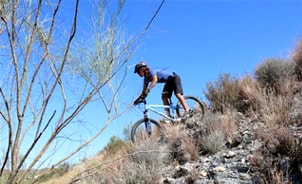
Morning after breakfast start the day one cycle trip up to New Tehri, the kitchen staff and luggage will go by supporting vehicle. Lunch will serve enroute, evening reach New Tehri check in and overnight stay at the hotel.
New Tehri: The newly established township is the districts headquarter of Tehri Garhwal. It is situated at an elevation between 1550 to 1950 mts. above sea level. A modern and well planned town, only 11 Kms. From Chamba & 24 Kms. From Old Tehri, it overlooks a massive artificial lake and a Dam. It will soon become an important centre of attraction on the completion of the dam.
TEHRI – DHARASU (1339meters/42 km)
The day’s destination Dharasulies at a slightly lower elevation to the north of Tehri. The road to it goes up and down in the mountains along the river Bhagirathi. We hit the road early in the morning to catch the beautiful sight of the river sparklingblue against the rising sun.
The river Bhagirathi is deemed holy in Hinduism because it is one of the two source streams of the Ganges. On its southerly course from the Himalayan mountains, itmeets with the other holy river the Alaknanda in Devprayag in Garhwal and is thereafter called the Ganges. The route of our Garhwal biking tour takes the northerly course, towards the source of the Bhagirathi.
There are two routes from New Tehri to Dharasu. We take the more scenic one so that you get to enjoy the stunning views of the Himalayan mountain range along the way. The 42 km long bike ride ends around sunset in the beautiful town of Dharasu, which is an important point in the Himalayan journeys, because it is the conjunction point of the Yamunotri and Gangotri Highways. Dinner and overnight stay in a tent.
Dharasu - Uttarkashi (1158 mts/28 Kms)
Two roads fork up from the famous Dharasu bend. We take the eastern one headed to Uttarkashi. The route passes through small towns such as Jaspur, Patara, Dunda Range, Nageshwar Dham and Joshiyara before ending at Uttarkashi. It’s about a 30-km long journey through a landscape dotted with temples and ashrams. We are now well and truly into ‘Devbhumi’ (land of gods) as Uttarakhand is popularly called.
Uttarkashi is named thus because of the many similarities it shares with Kashi (Varanasi) in Uttar Pradesh. In the Himalayas, it is situated on the banks of the Bhagirathi, which becomes the Ganges in the lower plains. Not far from Uttarkashi is the hill Varunavat, which marks the confluence of two rivers Varuna and Assi. Varanasi, too, is situated at the confluence of Varuna and Assi and derives its name from these two rivers. Both Uttarkashi and Varanasi have the famous Vishwanath Temple (The Lord of the World Temple) dedicated to Lord Shiva.
One major difference between the two towns is that Uttarkashi is located high in the hills at the elevation of 1158 meters. The bike ride from Dharasu to Uttarkashi has its tough moments. Upon arrival, we make time for a visit to the Vishwanath Temple. Dinner and overnight at a hotel in Uttarkashi.
UTTARKASHI – BHATWARI (1575 meters/35 km)
Uttarkashi onwards, our journey into the higher Himalayas continues. All along the way so far, we’ve followed the course of the Bhagirathi riverand continue to do so as we leave the holy town of Uttarkashi. The route goes northwards and takes a sudden U-turn after a place called Gangori.
The Garhwal biking trail then takes the eastward course and passes the towns of Maneri,Didsari, Malla, Pahi before ending at our destination for the day, Bhatwari, a quaint village with a population of around a thousand people. The village affords stunning sights of the surrounding mountains and is located right opposite the gorgeous ShankhDhara waterfall. We plan the day’s itinerary to take out at least an hour or two for the invigorating visit to the waterfall.
To give you a feel of a Himalayan adventure, we pitch tents in the evening for your accommodation. You can take a short stroll to the market at Bhatwari and try out its eatery. Overnight in the tent.
BHATWARI - HARSIL (2745 meters/40 km)
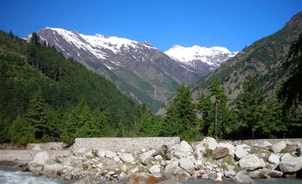
We gain some serious elevation on the road from Bhatwari to Harsil. The road goes northwards and on the last stretch of the journey it winds through a number of hairpin bends – first, at ChhotaChardham Yatra point, and then at Sukkhi Top. Biking here can get strenuous and the bikers always have the option of hitching a ride in our cab.
At first glance, Harsil bewitches you with its natural beauty. It’s a hill station and often called the ‘mini Switzerland’ of India. Even the Bhagirathi river, which is usually very turbulent, flows calm here. There’s a legend in Indian mythology about it. According to a local legend, the rivers Bhagirathi and Jalandhari once had a heated argument over their significance and superiority. They invoked the Lord Vishnu, also known as Hari, to intervene and settle the dispute. The Lord, however, did something ingenious. He transformed himself into a big rock (Hari Shila) to absorb their anger. Since then, the Bhagirathi has flown calmly here.
Bikers may also be surprised to find apple orchards in Harsil. They were introduced in these parts long ago by a British traveller. We dine and overnight at Harsil.
Harsil - Gangotri (3200 mts/30 kms)
After an early morning breakfast, we begin the ride to the source of the sacred Ganges river: Gangotri. The NH 34 winds eastward and takes a gentle southward curve at a place called Lanka before turning eastward again to end at Gangotri. It’s about a 30 km ride in the Greater Himalayan Range, replete with biking challenges and stunning views of the surrounding mountains.
Gangotri is one of the four holy pilgrimage sites in the Chota Char Dham circuit. The river Ganges (also called Bhagirathi here) originates here at a place called Gaumukh, which literally means a cow’s mouth and is named thus because of a cavernous mouth at the foot of the mountain from which the river flows. According to Hindu mythology, the Goddess Ganga descended here from Lord Shiva’s locks. Owing to the town’s religious importance, thousands of devotees visit it every year.
The town has the Gangotri Temple and Bhagirath Shila, where King Bhagirath is believed to have meditated and prayed to Lord Shiva. A short trek here leads to a cave called Pandava Gufa where the Pandava brothers (from the Mahabharata) are believed to have rested on their journey to Mount Kailash. We rest from our journey at a hotel in the evening and go out to visit the famous landmarks of Gangotri.
Gangotri - Gangnani (2133 mts/50 Kms)
Gangotri is an important point in our Garhwal biking tour. Whether you are a believer or not, an evening and night’s stay here calms the mind and rejuvenates the spirit because of Gangotri’s splendid location in the Himalayan range. It is also the end of NH 34. Hereon, we turn around and go back the way we came, but we choose to stop and overnight at different places.
Our destination for the day is Gangnani, about 50 km of bike ride from Gangotri. We lose elevation for the most part of the ride but that is not to say that biking to Gangnani is easy breezy. There are some tough stretcheson this route, but a dip in the hot springs of Gangnani washes away your fatigue.
Gangnani is a relatively peaceful town with spectacular views of the Himalayas. Devotees headed to Gangotri often stop here for a ritual bath in the hot springs. We overnight here in a tent.Gangnani - Uttarkashi (1158 mts) (50 Kms)
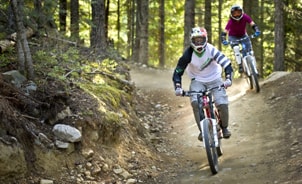
A morning bath in the hot springs of Gangnani is a good idea. We then have breakfast in our tents and hit the road towards Uttarkashi. To make this return journey exciting we have picked out several small villages for brief stopovers, villages such as Sungar, Kunjan, Pala Maradi, Dwari, Pahi, Janak and Maneri.
We cover a long stretch of 50 km and lose about a thousand meters of elevation. The ride is mostly downhill and gives us ample time to look around and explore some local places on the way. Photography buffs will be busy clicking away the beautiful landscape. Culture enthusiasts may interact with villagers and check out some lesser known temples.
The day’s biking ends at Uttarkashi, the holy city and the headquarters of the Uttarkashi district. We check into a hotel for dinner and overnight. In the evening, we go out to explore the old parts of the town that we may have missed out on during our previous visit.
Uttarkashi - Barhmakhal (1958 mts) (40 Kms)
Leaving Uttarkashi in the morning, we head back towards Dharasu, but at the Dharasu bend we switch highways. Remember the right road in the fork we previously took on the way to Gangotri? Now, we turn around at the Dharasu bend and take the left road going west. This road is national highway 134 and it goes up to Yamunotri.
This is an exciting stretch from the biking point of view, because the road throws up some sharp but short ascents during which we gain about 1000 meters of elevation. We pass through small towns such as Morgi, Kuthaldi, and Shrikot before reaching Brahmakhal, our destination for the day.
Brahmakhal has seen a lot of construction lately and is quite crowded in its central bazaar. We dine and overnight in a tent.
Barhmakhal - Barkot (2118 mts) (51 kms)
Brahmakhal to Barkot is a circuitous route along NH 134. We leave our tents after an early morning breakfast and take the road going northwards. On the way we cross small towns with temples. At a place called Wan, the road turns sharply towards south and meanders through the hills for about five km before turning north again.
Around mid-day we reach a place called Radi Top, where, again, the road forks. We continue going up NH 134 to Dandal Gaon after which the road again loops southward for a few kilometres before turning north. At a place called Chakragaon we come upon another split in the road and keep going up to Barkot. The distance from Brahmakhal to Barkot is about 51 km and cycling up some of the stretches on this route can be tough.
Located on the banks of the Yamuna river, Barkot is a sprawling town and an important pit-stop in the Yamunotri Dham pilgrimage. It has many temples, colleges, schools and bazaars. We check into a hotel for dinner and overnight.
Barkot - Nainbagh (1115 mts) (50 Kms)
At Barkot we start following the river Yamuna’s southerly course. We take National Highway 507 and cycle to the towns and villages of Kisna, Naugaon, Barnigarh, Gatu, and Kandi before reaching Nainbagh in the evening.
Nainbagh is a hill station blanketed with a dense forest of oak and rhododendron. Tourists wishing to flee the crowds of Mussoorie (a more popular hill station nearby) often head to Nainbagh to enjoy the peace, tranquillity and beauty of Garhwal mountains. Geographically, Nainbagh is located at the confluence of the three districts of Tehri, Uttarkashi and Dehradun. The hill station offers some opportunities for adventure sports as well. Not far is the Pantwari village, which is often the base camp for the famous Nag Tibba trek.
We spend the evening walking around Nainbagh and taking in its beauty. We dine and overnight in a tent.Nainbag - Mussoorie (2005 mts) (41 Kms)
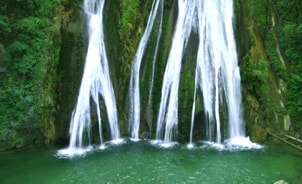
The fag end of our Garhwal biking adventure takes us to Mussoorie, the hill station often hailed as the ‘Queen of the Hills’. Though this famous tourist hotspot is located in the foothills of the Garhwal Himalayan Range, it lies at a greater altitude than Nainbagh. The biking trip to Mussoorie therefore tests your endurance.
But all the hard work is rewarded with stunning views along the way. We make enough time for the Kempty Falls, the beautiful waterfall just 15km from Mussoorie. Arriving in Mussoorie in the early evening, we go out to explore the town, do souvenir shopping, check out the eateries and soak in the celebratory holiday spirit of the town. Mussoorie’s high location affords breath-taking view of the Himalayas to the northeast and the Doon valley to the south. The spectacle is best enjoyed from Gun Hill, the second highest point of Mussoorie accessed by a cable car. A short ride away from the city is Mussoorie Lake where you may enjoy boat rides.
As this is the last night of the Garhwal biking tour, we live it up by celebrating the trip’s success at dinner. We overnight in a hotel in Mussoorie.
MUSSOORIE TO DELHI (DEPARTURE)
On the final day, we drive you to the Jolly Grant airport in Dehradun for a flight to Delhi. If you wish to travel by train, we may drop you at the railway station in Dehradun for your onward journey to Delhi. Garhwal biking tour comes to an end.
Bikes: Mountain Bikes
Bike Sizes: 13-21
Bike Hire: Includes on Tour Cost. You may bring your own bikes, but in this case let us know in advance. Other equipment provided: Pedals, helmet, water bottles.
Accommodation
Accommodation is offered at all locations. Most of the hotels are Culture Resort, Eco Resorts & family run hotels - all with a common line of quality in service. Our costs are based on 'twin-sharing' foundation. For those who wants single room, we offer single room, but at extra cost.
Terrain
The landscape includes flatlands, mountains, backwaters and village streets.
Climate
The variety of the regional features of this country has led to a corresponding variety in environment. The Great Varies have awesome environment throughout the year, while the flatlands are warm and moist. The common level of yearly rain fall is superb in Kerala, Sikkim and some of the Northern Eastern Declares of Native India, when compared to other Native India. July to Aug is the monsoon season, with heavy downpours. It is always recommended to check weather and temperature at websites.
Transportation/Support Vehicles
All transport is involved in the cost. We provide backup vehicle at all times during cycling trip. The vehicle can be used to boat your baggage & yourself as required.
Food
Food is a very essential part of these trips. We make sure that the meals we offer is method delicious, unless you ask for dull meals. You are also permitted the choice of veggie or non-vegetarian meals. We suggest that you consume only the canned standard water. Please make sure that the container is enclosed.
What to bring
Footwear
- Bike shoes
- Sun cream lotion
- Relaxed shoes for walking
- Shoes for other sightseeing
- Socks
Clothing
- In Indian, the conventional of outfit is more traditional. We counsel you to prevent very short shorts/skirts and limited tops/tanktops when viewing small non-urban places, temples, mosques or other sacred sites as this may limit your access.
- A hotter set of outfits (Fleece, Coat, hat and gloves) are required for visits going through Munnar and other thin air places.
- Water resistant jacket.
- Riding a bike equipment like safety gloves and shorts.
Others
- Torch
- Mosquito repellent
- Eyewear, cap
- Sun lotion of spf at least 35
- Individual Bike riding equipment like bar finishes, pedals, chairs and headgear
- Helmets for riding a bike
Health
Water is higher risk; hence we suggest that you drink only nutrient water in bottles during your trip. A cage of standard nutrient water is always focused for in the start of the vehicle during trips as an urgent evaluate. Despite the high requirements, it is worth providing basic OTC medications for disappointed tummies, complications, pest attacks etc. Indian is a financially creating democratic republic and has worked very hard to control illnesses. Sufficient medical care is available in the major inhabitants' facilities, but is usually limited in the non-urban areas of the country. Many western worlds are utilizing the state-of-the-art healthcare services available in Indian. The cost of treatment is much less expensive here in comparison to the same features available in innovative nations.
The most important cause of sickness of tourists in Indian is food and water-borne illnesses. Malware, bacteria, or harmful bacteria can cause diarrhea. Attacks may cause simple diarrhea and throwing up, high temperature, or, in extraordinary instances, liver organ damage (hepatitis). Malaria is a avoidable disease that can create trouble if neglected. One can prevent disease by taking recommended anti-malarial drugs and defending against insect attacks. The areas you will be passing are Malaria-free. Make sure that your insurance provider includes illnesses and injuries overseas.
Precautions
- Bring all the important medications and OTC medications. Do not ignore to have the brands as well as the general titles of the medications one needs to have.
- Use a sun hat when revealed.
- Consume a lot of liquids. Don't drink tap water. Use only bottled water which is always kept in the back of your automobile.
- Bring your personal medical kit and pest resilient.
- To avoid fungus and parasitic attacks, keep legs clean and dry, and do not go without shoes.
- Do not eat food bought from road providers.
- Do not drink drinks with ice.
- Do not eat milk products unless it is known that they have been pasteurized.
- Prevent managing creatures (especially apes, pets, and cats) to avoid attacks and serious illnesses.
Medical Information Update
Details given above are liable to change every now and then and one should contact the Native India tasks of the specific country or the government vacationer offices for more details.
Shopping
You will get possibilities en-route to do a bit of purchasing. However unless particularly requested for, our guide will not suggest any particular store. Neither we nor our driver/guides take any percentage on purchasing.
Spending Money
Every visitor will have different cash specifications and varying personal costs. Please assess your own spending routines while enabling for beverages, purchasing and falling. Also keep aside cash for extra costs like:
- Foods which are not included
- Emergencies
- Optionally available activities /additional sightseeing
- Shopping/Souvenirs
Foreign Exchange
As Indian currency value tend to go up and down, make reference to the following website for daily return rates: www.xe.com.
Airport Taxes
There is no airport terminal or leaving taxation from any airport terminal of India.
Exclusions
- Insurance Policy - Please take your own Insurance
- Tips
- Beverages
- Laundry
- Telephone bills
- Cycles
- Support Vehicle, parking, toll, driver's allowances
- Cycling guide
- Breakfast at all destination
- All Accommodation on Full board
- First Aid Kid
- Backup of Support Vehicle

